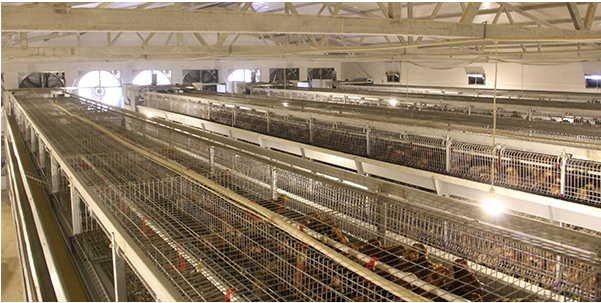Chicken density of automated breeding equipment
- font size
- Be the first to comment!
The number of chickens that can be accommodated per square meter of breeding area for chickens raised by Fully automatic poultry farming equipment for chicken is called the stocking density, and the feeding and drinking position of each chicken is also an indispensable condition for mastering the stocking density. If the density is too high, the chicken flocks are crowded, the environmental humidity is increased, the feeding is uneven, the chicken flocks are not well developed, and they are susceptible to diseases and pecking habits. The physique of the chickens becomes weak, the mortality rate increases, and the growth rate decreases. Although the density is small, it is good for the survival and growth of the chicks, but it is not good for heat preservation and uneconomical. The density should be adjusted according to factors such as the type, breed, brooding method, season, age, and ventilation of the chicks. Automatic breeding equipment cage brooding should sparse the group as the age increases. The density should be reduced by about 30% at the age of 3-4 weeks, and the density should be reduced by about 15% at the age of 5-6 weeks.
Egg-type chicks at the age of 1-4 weeks occupy a trough position of 2 to 2.5 cm each, and increase to 5.0 cm each at 5-6 weeks of age. If a bucket is used, each bucket can feed 35 chicks at the age of 1-4 weeks, and each bucket can feed 25 chickens at the age of 5-6 weeks. If a sink is used, the location of the sink for each chick from 0-6 weeks old is 1 to 2 cm.
Broiler chickens are suitable for higher-density rearing, but it also depends on specific conditions. Generally, on-line flat rearing has a higher density than bedding ground, and the ventilation conditions are good, and the density can be increased appropriately. In winter, the stocking density can be increased by 10%, and in summer, it should be reduced by 10%-20%. Because broiler chickens grow fast, they are generally available at 40-45 days of age, so the stocking density of their automated breeding equipment is calculated based on the number of chickens per square meter when they leave the factory. Reasonable feeding density can provide the chicks with equal opportunities for drinking and eating, which is conducive to improving the uniformity, and can also prevent the habit of the chicks from pecking the anus and feathers. At the same time, pay attention to the air quality and ventilation requirements of the chicken house.



